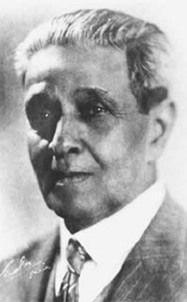Ernesto Nazareth facts for kids
Quick facts for kids
Ernesto Nazareth
|
|
|---|---|

Ernesto Júlio de Nazareth
|
|
| Background information | |
| Born | March 20, 1863 Empire of Brazil |
| Died | February 1, 1934 (aged 70) |
| Genres | Classical |
| Occupation(s) | Composer |
| Instruments | Piano |
Ernesto Júlio de Nazareth (born March 20, 1863 – died February 1, 1934) was a famous Brazilian composer and pianist. He was especially known for his amazing Maxixe and Choro music.
Ernesto Nazareth mixed different rhythms like the polka, the habanera, and the lundu. He combined these with his classical music training. He called his new songs "Brazilian tangos." These tangos later helped create the music style we now call Choro. Today, his piano music is taught in both classical and popular music schools. This shows how he connected these two different music worlds.
Contents
Ernesto Nazareth's Life Story
Ernesto Nazareth was born in Rio de Janeiro, Brazil. He was one of five children. His mother, Carolina da Cunha, gave him his first piano lessons. When he was ten, his mother passed away. He then continued his piano studies with Eduardo Madeira and Charles Lucien Lambert.
Ernesto was greatly inspired by the composer Chopin. He published his first song, Você Bem Sabe (which means "You know it well"), in 1877. He was only 14 years old. Around that time, he started playing piano professionally. He performed in cafes, at dances, at fancy parties, and in the waiting areas of movie theaters.
In 1879, he wrote his first tango, Cruz perigo. The next year, at age 17, he played in public for the first time at the Mozart Club. In 1881, he composed the tango Não caio n'outra. This song became a huge hit and was printed many times. In 1885, he performed concerts in different clubs. In 1893, a music company called Casa Vieira Machado released more of his songs. This included the tango Brejeiro. This song became popular across Brazil and even internationally. The Republican Guard band of Paris started playing it and even recorded it.
His first concert as a solo pianist was in 1898. The next year, he released the first version of his tango Turuna. In 1905, his song Brejeiro was recorded for the first time. A singer named Mario Pinheiro sang it with new words. Around the same time, a marching band recorded his tango Brushed, which also became very successful.
In 1907, Ernesto Nazareth was offered a job as a book-keeper at the National Treasury. This is a government office that handles money. However, he did not take the job because he didn't know English. In 1908, he started working as a pianist at the Mozart Club.
The next year, he played in a concert at the National Institute of Music. He performed his gavotte Corbeille de fleurs and the tango Batuque. He also began teaching piano lessons to students. From 1920 to 1924, he worked as a pianist at the Odeon Cinema. He also played for "Casa Gomes" in 1921. He performed many shows in São Paulo and Campinas, including at the Municipal Theater. His fans even gave him a grand piano as a gift! He was one of the first artists to play music for the Society Radio of Rio de Janeiro. In 1932, he gave a special concert where he played only his own songs.
In 1933, Ernesto Nazareth faced some difficult times. He had been struggling with his mental health after his wife and daughter passed away. He also had worsening hearing problems from a fall when he was a child. He was admitted to a special hospital in Jacarepaguá. He passed away there in February 1934.
Ernesto Nazareth's Music
Ernesto Nazareth was known for mixing many different music styles in his songs. He used Brazilian music, but also sounds from Europe, Africa, and ragtime. Many of his songs are still played today. He wrote 88 tangos, 41 waltzes, and 28 polkas. He also composed many sambas, galops, quadrilles, Schottisches, fox-trots, and other types of music. In total, he completed 211 musical pieces.
About Some of His Famous Songs
The song Escovado means "smart" in common Brazilian slang. A writer named Ary Vasconcelos said that Nazareth was a loving family man. He often named his songs after his children, wife, or other relatives. For example, Travesso was for his son Ernesto. Marieta and Eulina were for his two daughters. Dora was for his wife Theodora. Brejeiro was for his nephew Gilbert.
Escovado was first published by Casa Vieira Machado & Co. He dedicated it to his younger brother, Fernando Nazareth. It became one of Nazareth's biggest hits. A French composer named Darius Milhaud even used the main tune from Escovado in his own famous work, Le bœuf sur le toit (1919). In September 1930, Ernesto Nazareth recorded this song himself.
Brejeiro is one of the songs you can hear in the video game Civilization VI. It plays when you are playing as Brazil. The music for the game was created and directed by Geoff Knorr.
See also
 In Spanish: Ernesto Nazareth para niños
In Spanish: Ernesto Nazareth para niños


